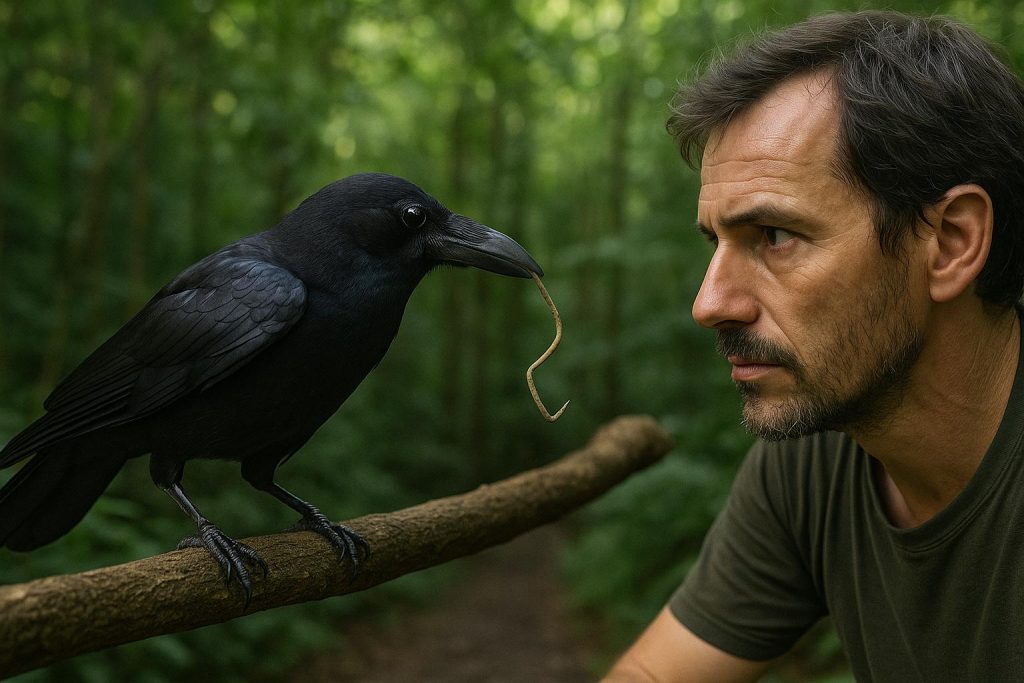A Deep Conversation or A Walk in The Park?
By Rose Polipi

Image Credit: Rose Polipi
Once upon a time, humans spoke alone. Or so we believed.
We sang our symphonies of thought across continents, wrote languages into stone, and built towers of logic into the sky. And all the while—beneath the waves, above the treetops, and right outside our windows—voices called out.
We simply didn’t know how to listen.
Now, machines are helping us hear.
This is not science fiction. This is the moment where fiction folds into fact. Artificial Intelligence, once the province of chatbots and number crunchers, is decoding the dialects of birds, the grammar of whales, and the emotional subtext of pigs.
And it is doing so with such speed, accuracy, and subtlety that one truth is becoming unavoidable:
We were never the only ones speaking.
The Whale Who Clicked Back
Picture this: the vast blue cathedral of the Caribbean. A sperm whale clicks—not once, not randomly, but with deliberate rhythm. Codas. Structured sequences. Messages. Music.
Shane Gero, a marine biologist with the patience of a monk and the ears of a poet, has spent two decades listening. He hears grief. Reunion. Joy. Questions, even. But knowing isn’t enough. Understanding requires translation.
Enter Project CETI—a global alliance of linguists, biologists, and machine learning pioneers. With data from Gero and neural networks shaped by MIT’s Daniela Rus, AI now identifies individual whales with 99.3% accuracy—based solely on their clicks.
Now comes the question that chills the spine: Can AI talk back?
The goal is audacious. To isolate not just vocabulary, but meaning. To determine if whales ask, argue, joke. To build a whale chatbot, not to command them—but to understand them.
It’s not about language. It’s about humility.
The Birds Are Not Just Singing. They Are Writing.
In the forests of Australia, a zebra finch flutters its wings and opens its beak. What emerges is not a simple call. It’s artistry. Variation. Pattern. Nuance. Preference.
In 2022, AI decoded microtonal changes in finch songs that even seasoned ornithologists had missed. These notes weren’t random—they were love letters. Females responded more favorably to certain flourishes, indicating that male birds were composing songs with purpose and poise.
AI had discovered the dialect of desire.
Thanks to multimodal AI—systems that don’t just hear, but also see, feel, and contextualize—we now know that birds use gesture, rhythm, and environment to craft a communication style as rich as our own.
Through apps like Merlin, anyone can join the symphony. Record a birdsong. Upload. Discover the species, its meaning, its emotional signature.
You are no longer just a listener. You are a translator of Earth.
Pigs, Dogs, and the Rise of Emotional Algorithms
Imagine this: a farm in Denmark. A pig squeals. Previously dismissed as noise, that squeal now passes through a neural network trained to identify emotional states.
The machine says: joy.
Elodie Briefer’s team has created AI that doesn’t just hear animals—it feels with them. By recognizing vocal frequencies tied to stress, delight, and anticipation, the farm becomes a feedback loop of empathy.
In Arizona, biologist Con Slobodchikoff programs algorithms to decode the facial expressions and vocal cues of dogs. These systems can detect anxiety, excitement, even jealousy.
What was once dismissed as anthropomorphism is now being reframed as recognition. Not projection, but respect.
The Geometry of Meaning
In 2017, the tectonic plates of linguistic science shifted. AI began decoding human languages without translations, using the geometry of meaning—mapping the relationships between words like stars in a constellation.
That same math is now being applied to animal speech. Instead of trying to assign English words to foreign sounds, AI builds semantic spaces, revealing how animals may structure thought, intention, and interaction.
The world is no longer divided into those who speak and those who don’t. It’s divided between those who are heard—and those who are still waiting.
The Moral Cost of Understanding
But beware: every new tool has its shadow.
What if we mimic a whale’s voice so perfectly that we deceive its entire pod? What if poachers use synthetic birdcalls to trap endangered species? What happens when corporate interests exploit communication to control rather than connect?
Karen Bakker, author of The Sounds of Life, warns:
“A synthetic whale song released into the ocean could become the first viral meme of the animal world—one with consequences we can’t yet imagine.”
Aza Raskin, co-founder of the Earth Species Project, offers a chilling twist:
“We may talk to animals before we understand them.”
The question isn’t can we speak with animals. It’s should we, and how.
What Language Was Always Meant to Be
Not all data comes with syntax. Not all meaning needs words.
A crow curves a hook from a twig—not by instinct, but by iteration, reflection, purpose. A prairie dog chirps in alarm—not just “danger,” but “tall human in red shirt approaching quickly.” A whale clicks—and its pod answers, not with facts, but with feeling.
These aren’t simple signals. They are the primal bones of storytelling: Grief. Hunger. Joy. Reunion. Longing. Love.
Not just communication—but communion.
A New Babel, or a New Beginning?
We once believed the Tower of Babel shattered language into incomprehensible shards. But what if, all along, the shards were never broken? What if we were just too loud, too fast, too human to hear the others?
Now, in an era shaped by silicon minds and digital ears, we are discovering the truth: We are surrounded by ancient wisdom. Spoken in tones, sung in feathers, breathed beneath waves.
AI isn’t making animals speak. It’s proving they always did.
And for the first time in history, we’re beginning to answer.
